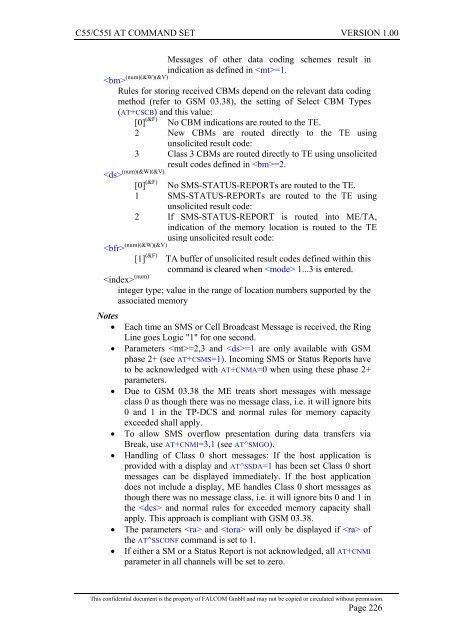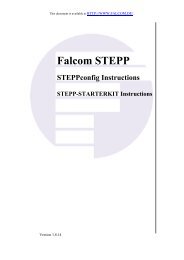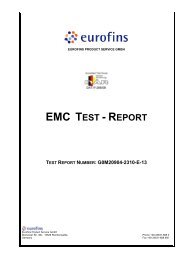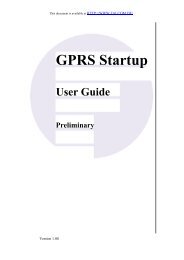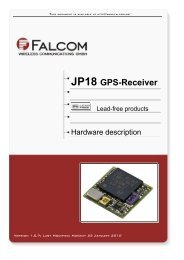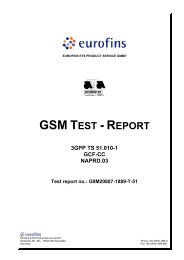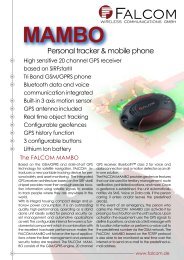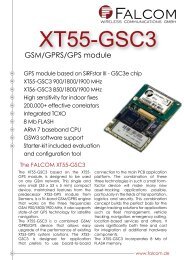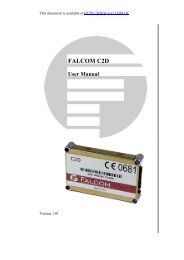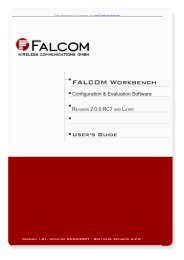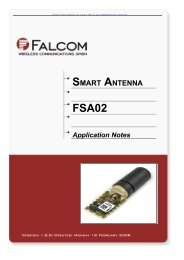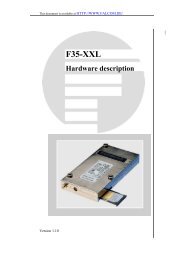C55/C55i AT COMMAND SET Description Preliminary - Falcom
C55/C55i AT COMMAND SET Description Preliminary - Falcom
C55/C55i AT COMMAND SET Description Preliminary - Falcom
Create successful ePaper yourself
Turn your PDF publications into a flip-book with our unique Google optimized e-Paper software.
<strong>C55</strong>/<strong>C55</strong>I <strong>AT</strong> <strong>COMMAND</strong> <strong>SET</strong> VERSION 1.00<br />
Messages of other data coding schemes result in<br />
indication as defined in =1.<br />
(num)(&W)(&V)<br />
Rules for storing received CBMs depend on the relevant data coding<br />
method (refer to GSM 03.38), the setting of Select CBM Types<br />
(<strong>AT</strong>+CSCB) and this value:<br />
[0] (&F) No CBM indications are routed to the TE.<br />
2 New CBMs are routed directly to the TE using<br />
unsolicited result code:<br />
3 Class 3 CBMs are routed directly to TE using unsolicited<br />
result codes defined in =2.<br />
(num)(&W)(&V)<br />
[0] (&F) No SMS-ST<strong>AT</strong>US-REPORTs are routed to the TE.<br />
1 SMS-ST<strong>AT</strong>US-REPORTs are routed to the TE using<br />
unsolicited result code:<br />
2 If SMS-ST<strong>AT</strong>US-REPORT is routed into ME/TA,<br />
indication of the memory location is routed to the TE<br />
using unsolicited result code:<br />
(num)(&W)(&V)<br />
[1] (&F) TA buffer of unsolicited result codes defined within this<br />
command is cleared when 1...3 is entered.<br />
(num)<br />
integer type; value in the range of location numbers supported by the<br />
associated memory<br />
Notes<br />
• Each time an SMS or Cell Broadcast Message is received, the Ring<br />
Line goes Logic "1" for one second.<br />
• Parameters =2,3 and =1 are only available with GSM<br />
phase 2+ (see <strong>AT</strong>+CSMS=1). Incoming SMS or Status Reports have<br />
to be acknowledged with <strong>AT</strong>+CNMA=0 when using these phase 2+<br />
parameters.<br />
• Due to GSM 03.38 the ME treats short messages with message<br />
class 0 as though there was no message class, i.e. it will ignore bits<br />
0 and 1 in the TP-DCS and normal rules for memory capacity<br />
exceeded shall apply.<br />
• To allow SMS overflow presentation during data transfers via<br />
Break, use <strong>AT</strong>+CNMI=3,1 (see <strong>AT</strong>^SMGO).<br />
• Handling of Class 0 short messages: If the host application is<br />
provided with a display and <strong>AT</strong>^SSDA=1 has been set Class 0 short<br />
messages can be displayed immediately. If the host application<br />
does not include a display, ME handles Class 0 short messages as<br />
though there was no message class, i.e. it will ignore bits 0 and 1 in<br />
the and normal rules for exceeded memory capacity shall<br />
apply. This approach is compliant with GSM 03.38.<br />
• The parameters and will only be displayed if of<br />
the <strong>AT</strong>^SSCONF command is set to 1.<br />
• If either a SM or a Status Report is not acknowledged, all <strong>AT</strong>+CNMI<br />
parameter in all channels will be set to zero.<br />
This confidential document is the property of FALCOM GmbH and may not be copied or circulated without permission.<br />
Page 226


